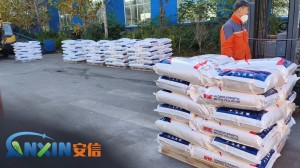Hydroxypropyl Methylcellulose (HPMC) is a nonionic cellulose ether formed by chemical modification of natural cellulose. It features excellent thickening, water retention, film formation, adhesion, suspension and stabilization properties, and is widely used in multiple fields such as building materials, pharmaceutical preparations, daily chemicals and food processing. It is currently one of the cellulose ether products with the largest application volume and the most balanced performance.
1.The basic properties of HPMC
1.1. Chemical properties
HPMC belongs to etherified cellulose. Its molecular structure contains methoxy (-OCH ₃) and hydroxypropoxy (-OCH ₂CH(OH)CH₃) substituents, which endows it with excellent solubility and stability. Due to its nonionic structure, it does not react with metal salts and is not affected by pH value, thus maintaining stable performance in a wide range of systems.
1.2. Appearance and Form
HPMC is usually a white or off-white powder, odorless, tasteless, non-toxic, with uniform particles, easy to flow, and convenient for storage and transportation.
1.3. Solubility
HPMC is instant soluble in cold water. It is first dispersed in hot water, cooled and then dissolved into a transparent and viscous liquid. Its solution has high transparency and stable rheological properties.
1.4. Thermogel properties
HPMC is temperature-sensitive. When the temperature rises to the gel point, the solution will solidify. After the temperature drops, it can resume flowing, which is the key principle for enhancing anti-sagging and improving workability in building materials.
2. Core functions of HPMC
2.1. It has remarkable water retention performance
This is the most crucial role of HPMC in building materials. It can lock in water in cement-based or gypsum-based systems, delay water evaporation, fully hydrate the material, enhance strength and reduce hollowing and cracking.
2.2. Thickening and regulating rheological properties
HPMC can significantly increase the viscosity of the system, improve the feel of construction operation, make the slurry smoother, easier to brush or scrape, and at the same time enhance the anti-sagging ability.
2.3. Improve adhesion
In systems such as tile adhesives, grout agents, and self-leveling agents, HPMC can enhance the wettability and adhesion of materials, and increase the reliability of bonding.
2.4. Film-forming property
HPMC can form a uniform and transparent film on the surface, which has certain protective, adhesive and flexible properties. It is particularly important in pharmaceutical preparations and daily chemical products.
2.5. Lubrication and conformal function
In extrusion and granulation processes, HPMC can reduce friction and improve the forming quality of products.
3. Main application fields of HPMC
3.1. Construction materials field (with the largest usage)
Tile adhesive, stone adhesive: Enhance water retention, open time, adhesion and workability.
Putty powder: Enhances spreadability, fineness and anti-sagging ability.
Mortar (plastering, masonry, repair) : Promotes uniform mortar, appropriate viscosity, and smoother construction.
Gypsum products: Improve the setting process, enhance water retention and fluidity, and reduce cracking.
Self-leveling materials: Enhance flow regulation and suspension stability.
External wall insulation system (EPS/XPS) : Enhances the stability and strength of bonding mortar and plastering mortar.
Although the addition amount of HPMC in the construction field is low (usually 0.1% – 0.5%), it plays a significant role and is an irreplaceable key additive in most dry-mixed mortars.
3.2. Medical field
After reaching the pharmaceutical grade standard, HPMC can be used as:
The binder of tablets
Controlled-release materials, coating materials
Raw materials for transparent capsule shells (plant capsules)
Eye drop thickener, gel matrix
It is highly safe, non-toxic and biodegradable, and is an excellent pharmaceutical excipient among both natural and synthetic materials.
3.3. Daily chemicals and other industrial applications
Detergents, hand sanitizers and body washes: They play a role in thickening, suspending and stabilizing.
Coatings and inks: Improve dispersibility, rheology and film-forming performance.
Latex paint: Enhances thickening property, water retention and construction feel.
Food processing (food grade required) : As an emulsifying stabilizer, thickener and film-forming agent.
PVC industry: As a dispersant in polymerization reactions.
4. Key points for selecting HPMC
4.1. Selection of viscosity grades
The effects of HPMC with different viscosities are significantly different:
Low viscosity (400-15,000 CPS) : Suitable for self-leveling, rubber powder, polystyrene particle and other systems.
Medium viscosity (20,000-50,000 CPS) : Commonly used in putty powder and plastering mortar.
High viscosity (60,000-200,000 CPS) : Suitable for tile adhesives and systems with high water retention requirements.
4.2. The degree of substitution matches the formula
The degree of substitution affects the dissolution rate, water retention and anti-slip performance. Different models should be selected for different applications.
Dissolution rate (fast-dissolving type/delayed type)
The fast-dissolving type is suitable for systems with mild mixing methods such as putty and coatings
The delayed type is suitable for powerful mixing systems such as mortar and tile adhesive
5. Storage and Security
HPMC is a powder product and should be stored in a cool and dry place to avoid moisture and caking. It is non-toxic, odorless and highly stable in itself. During use, only dust protection needs to be noted.
Hydroxypropyl methylcellulose (HPMC), with its outstanding water retention, thickening, film-forming and stability properties, plays an irreplaceable role in numerous fields such as construction, medicine, daily chemicals, food and industrial processing. Although the addition amount is not high, it is one of the key factors in improving performance in modern building materials and daily product formulas.
Post time: Nov-11-2025

